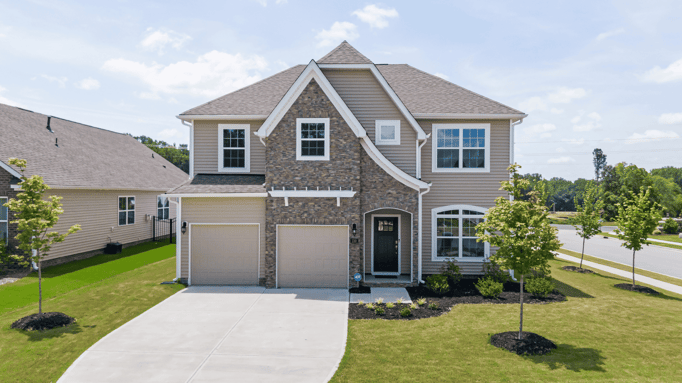Do You Need A Raise To Be Able to Afford A House in 2025?
 Author: Michael Bernstein
Author: Michael BernsteinPublished:
Homeownership in 2025 feels more out of reach than ever—unless you're looking in the right places. While national headlines paint a grim picture, many Texas markets are still offering pathways to ownership that just don’t exist on the coasts. With mortgage rates hovering near 7%, the typical American household would need a $17,670 raise to afford a median-priced home, according to new data from Zillow.
But here’s the good news: You don’t need a $17,000 raise to become a homeowner—especially in Texas. Rates can fall. Sellers can negotiate. And there are creative, legal ways to bridge the affordability gap without waiting for your boss to hand you a promotion.
In emerging areas like Celina, just north of Dallas, brand-new homes with yards and space are still available at a fraction of what you'd pay in California or New York. Houston and San Antonio remain two of the most income-accessible major metros in the country, and even Austin is seeing real opportunities thanks to falling prices and rising inventory.
This guide will unpack where affordability stands today, why it's so much worse than five years ago, and what you can do about it—especially if you're buying in Texas markets like Austin, Houston, San Antonio, or Celina, where affordability is holding up better than most.

What the Data Says: Texas Is Holding Up Better Than the Coasts
Nationwide, homeownership has become a stretch for the average household. But some Texas housing markets are still within reach.
Zillow’s 2025 affordability report found:
- In Houston, buyers only need an extra $6,304 above the median income to afford a median-priced home
- In San Antonio, the gap is just $8,064
- In Dallas, it’s $17,448—almost exactly the national average
- In Austin, the gap is higher at $27,545, but it’s shrinking fast thanks to falling prices and rising inventory
By comparison, buyers in San Francisco or Los Angeles need six-figure raises just to qualify.
These numbers underscore a critical truth: Texas is still one of the most buyer-accessible major housing markets in the country.
And across the state, local trends show distinct momentum in favor of buyers:
- In Houston, more first-time buyers are qualifying with creative programs and builder incentives, especially in emerging neighborhoods outside the Beltway. Many are opting for new communities in areas like Cypress, Richmond, and Katy, where pricing remains more manageable and developers are offering substantial perks.
- San Antonio is a top pick for affordability, with lower property taxes and more new construction options compared to other large metros. Buyers can still find move-in-ready homes under $300,000 in neighborhoods like Converse and Cibolo.
- Dallas has shifted back into a buyer's market, with rising inventory and more negotiation room than we've seen in years. Areas like Mesquite, Garland, and Forney are seeing price reductions and builder-led incentives that didn’t exist just a year ago.
- Austin is seeing real price relief in 2025. After a massive run-up in values, softening prices and higher listing volume mean buyers finally have leverage again. Inventory is back to pre-pandemic levels, and the frenzy has given way to thoughtful negotiations, especially in East Austin and the surrounding suburbs.
Whether you're looking for a suburban starter home in San Antonio or a price-reduced property in East Austin, Texas buyers have real opportunities to act—with the right strategy and support.
Austin Buyers: Why Now Might Be the Right Time
After years of record-breaking growth, Austin’s housing market has cooled:
- Prices have come down from their 2022 peak
- Inventory is up, giving buyers more choices
- Sellers are cutting prices and offering concessions, especially on homes that have sat for more than 30 days
If you’re a buyer in Austin, this is the most favorable market since before the pandemic. You may not see price drops of this scale again—especially if mortgage rates fall and demand rebounds.
Pro Tip: Many Austin sellers are offering closing cost credits or buydowns on interest rates. Make sure your lender is ready to help you take advantage of those incentives.
What’s Driving the Affordability Gap?
The affordability challenge isn’t just about high prices. It’s the combination of several compounding factors that built up over the last five years:
-
Soaring Home Prices
Home values rose nearly 50% from 2019 to 2024, outpacing wage growth and making larger down payments necessary. That said, prices have recently begun to cool, particularly in overheated markets like Austin and Dallas. Price corrections and an uptick in listings mean buyers in 2025 are often paying less than those who purchased at the peak in 2022.
-
Higher Mortgage Rates
The average 30-year fixed rate went from sub-3% in 2020 to nearly 7% in 2025, more than doubling monthly housing payments for many buyers. Even though rates have stabilized, this jump has shifted the math on affordability for most first-time homebuyers. Many are now choosing ARMs or temporary buydowns to offset the impact.
-
Stagnant Income Growth
Even in strong job markets like Texas, incomes haven’t kept up. For first-time buyers, especially those in their 20s and 30s, this gap is hardest to overcome. JPMorganChase data shows that while wage growth for younger buyers was strong in nominal terms, it fell short once you adjust for the doubling in housing costs.
That said, if you believe you’re underpaid—don’t be afraid to ask for a raise. It’s uncomfortable, but your ability to qualify for a home loan (and enjoy a better lifestyle) is directly tied to income. Advocate for yourself, build your case, and make the ask. A higher salary now could unlock homeownership and build wealth for decades to come.
-
Rising Monthly Costs
Beyond the mortgage itself, buyers face rising costs for insurance, property taxes, and closing costs, especially in fast-growing metros. In many parts of Texas, rising replacement costs and natural disaster risk have pushed home insurance premiums significantly higher. At the same time, property tax assessments are catching up to the last decade of appreciation—further stretching monthly budgets.
Despite all this, it’s worth emphasizing: prices have begun to moderate. In cities like Austin, Dallas, and San Antonio, we’re seeing real price relief and more frequent price cuts—an early sign that affordability is slowly trending back in buyers' favor.
Six Ways to Make Buying in Texas Work in 2025
Here’s how today’s successful buyers are navigating affordability:
-
Bet on Lower Rates (and Refinance Later)
Many buyers are stretching today with the expectation that they'll refinance into a lower rate in the next 12–36 months. If rates fall just 1%, your monthly payment could drop by hundreds every month!
Use adjustable-rate mortgages (ARMs) or temporary buydowns (like 2-1 buydowns) to lower your initial costs—especially if your goal is to refinance within 1–2 years.
-
Get a Down Payment Gift
According to Zillow, 38% of buyers used a down payment gift from family or friends. In Texas, it’s common for parents to help adult children buy their first home. If you’re fortunate enough to receive help from family, follow the rules carefully—and use it to close the gap quickly. A modest gift can transform an “almost” into a “yes” in cities like Austin, Houston, San Antonio, and beyond.
-
Work With a Mortgage Broker (Not Just a Bank)
Mortgage brokers can shop across dozens of wholesale lenders to find more flexible guidelines, better terms, and competitive rates—especially for buyers with complex income or lower credit.
At LendFriend, we’ve helped Texas buyers qualify with just 3% down, use bank statement programs, and secure non-QM loans that banks won’t touch.
-
Use State & Local Assistance Programs
Texas offers a wide array of down payment assistance and grant programs, including:
- My First Texas Home
- Homes for Texas Heroes
- City-level assistance in Austin, Houston, and San Antonio
Many of these include below-market interest rates or forgivable second loans.
-
Target Submarkets & Suburbs
Affordability varies significantly by neighborhood. In Austin, for instance, suburbs like Kyle, Leander, and Manor offer brand-new homes for far less than central areas. In Houston and San Antonio, similar opportunities exist.
Talk to your lender about property tax differences by zip code—it could impact your monthly payment by hundreds.
-
Consider Builder Incentives or Smaller Homes
Texas has a robust pipeline of new construction. Builders are:
- Offering 2-1 buydowns
- Covering closing costs
- Discounting move-in-ready homes
New construction often includes warranties, energy efficiency, and fewer repair costs. But be cautious—many new homes in Texas are built quickly and with cost-cutting materials. That doesn’t mean new construction should be avoided, but it does mean you need to be diligent. Always get an independent third-party inspection, research the builder’s track record, and don’t assume brand-new equals problem-free.
And if you're not buying new construction? LendFriend offers a free 1/0 buydown for eligible borrowers—a powerful way to reduce your interest rate in the first year and ease into your mortgage payment. A 1/0 buydown means your interest rate is reduced by 1% in the first year of your mortgage, then returns to the full note rate in year two. It's a simple, lender-paid strategy to ease the transition into homeownership—especially helpful for buyers expecting income growth or future refinancing opportunities.
Should You Wait?
Waiting might give you a lower rate, but also:
- Home prices could rebound
- Inventory could tighten again
- You might miss out on current incentives
The housing market doesn’t move in a straight line. While interest rate cuts may come later in 2025 or 2026, there’s no guarantee they’ll be significant—or that they’ll arrive before prices begin to rise again. In fact, lower rates often trigger renewed competition, driving up home prices and reducing buyer leverage.
Texas markets like Austin and Dallas are already showing signs of stabilization. Many buyers who waited in 2023 and 2024 missed out on price reductions, seller credits, and flexible terms that are harder to negotiate in a hot market.
Meanwhile, today’s buyers are benefiting from motivated sellers, builder discounts, rate buydowns, and more room to negotiate repairs or closing costs. You may not get all of that if you wait.
If you find a home you love and can afford—even with today’s rate—you can refinance later. You can’t go back in time to buy at today’s price, but you can position yourself to win long term by getting into the right home now.
Final Thoughts: Texas Buyers Still Have a Path
The affordability gap is real. But in Texas, it’s smaller than most of the country—especially in cities like San Antonio, Houston, and Austin, where prices are stabilizing and sellers are flexible.
If you're thinking about buying in 2025, you don't have to wait for the perfect conditions. With the right strategy and the right mortgage partner, you can make the numbers work.
At LendFriend Mortgage, we specialize in helping Texas buyers find creative ways to close that gap—from gifts and grants to smart financing options that banks won't offer.
Have a question or need help asking your boss for a raise? Give us a call at 512.881.5099 or get in touch with me by completing this quick form, and I'll reach out as soon as possible.

About the Author:
Michael Bernstein